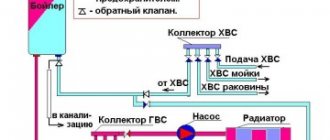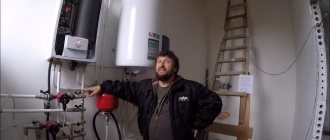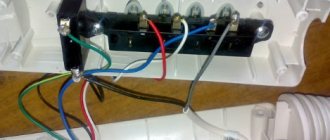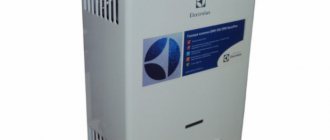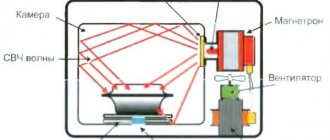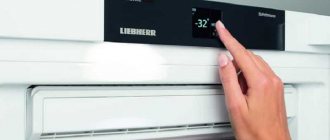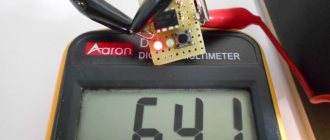Optimal temperature conditions
If you think that an air conditioner works like any heating device, you are mistaken; A split system does not produce heat, but transfers it from one environment to another, so it is very important to maintain the optimal temperature regime. In the case of heating work - from the street to a house or apartment.
The efficiency of an air conditioner depends on the difference in temperature between the room and outside. The larger it is, the worse the efficiency of the air conditioner and its performance. Every air conditioner has a minimum temperature at which it can produce heat.
Inverter air conditioners can operate for heating when it is -20...-30 degrees outside (depending on the model). Ordinary - at a temperature of -5...+5 °C, no less.
And even then, at a minimum temperature, the air conditioner will not be able to warm the air to more than +18…+21 degrees. Therefore, it is worth knowing at what temperature you can turn on the air conditioner for heating in winter.
Is it possible to turn on the air conditioner for heating in winter?
The question posed by this section has one background. Namely, all winter-summer air conditioners, and these are split systems, can be used as a heating device. More often, as an auxiliary to the main heating network. But they can only work at a certain temperature. That is, the manufacturer accurately indicates the minimum temperature conditions at which air conditioners can be operated.
Most often it is minus 5-10C. For inverter models, this limit is slightly lower - up to minus 15C. That is, if the outside temperature is below these parameters, then turning on the device is prohibited. The external unit will simply freeze, which will lead to its breakdown.
Installation of air conditioning system
Air conditioners should be operated in strict compliance with the most necessary standards, including correct installation of the system - this action will ensure that the service life is extended to the maximum, and also relieves owners of climate control equipment from the need for expensive and frequent repairs, which, as a rule, are carried out with the replacement of expensive parts such as compressor or control board.
Before installing the air conditioner, you need to study the instructions in detail, which indicate how best to perform these actions, as well as how to turn on the air conditioner on heat. Experts advise not to skimp on such important actions as installation, but to trust the professionals. But you need to figure out the basic functions yourself.
The installation of the system must be carried out in accordance with the generally accepted rules for using this device - you need to provide the system with easy air inflow and outflow.
Switching the air conditioner to heat is carried out using the air conditioner control panel (remote control or wall-mounted). The heat mode of the air conditioner is usually indicated on the control panel by an icon with the image of the Sun.
In addition, to operate air conditioners before using it, you need to conclude a special agreement with the company that is its supplier regarding the service of this system.
Before you start using an air conditioner, you need to know all the details and features of its operation - how to turn the air conditioner on hot or cold, how often should it be ventilated, and is it possible to carry out preventive maintenance yourself? Everyone should know that regular maintenance of this unit will prevent premature failure of the system. This, for example, often happens in the summer - at a time when service companies are fully loaded with orders and simply have no way to quickly respond to a call or restore the functionality of your particular system. So, if your climate control equipment suddenly breaks down during a difficult period for repair, and you don’t want to ruin it completely, you shouldn’t start repairing it yourself. You should disconnect the air conditioner from the network and wait for a specialist who can carry out a truly qualified repair, taking into account his knowledge in this area.
How to use air conditioning in sub-zero temperatures?
“The problem with using an air conditioner in winter is that the blades of the external unit become covered with ice and freeze. They cannot spin, and if they are started, then the overheating protection starts to work. All air conditioners that can be used at sub-zero temperatures have a system that preheats the device. It first warms it up with warm air from the room, and heating the crankcase also warms up the oil in the heat exchanger,” says Dranitsky.
Questions and Answers
Will air conditioning improve the air in an apartment if the windows face the road? For an air conditioner that was not initially designed to operate at low temperatures, you can additionally install compressor crankcase heating. It will heat the oil in the compressor while it is off and turn off when the compressor is running. The installation of the crankcase heating must be carried out by a specialist, since this requires complete disassembly of the outdoor unit. It is also necessary to install heated drainage of the indoor unit. It is installed on the drainage hose where it exits from the wall to the street. Heating the drainage is important, since when the condenser of the outdoor unit defrosts, a lot of water is formed, and if its drainage is difficult, then when it freezes, it will simply damage the condenser.
How does an air conditioner work for heat?
Any split system is based on the principle of circulation of freon, which goes through various phases, either boiling or turning into gas, thereby releasing thermal energy into the surrounding space, that is, working for heating. It all depends on the junction temperature, which is controlled by the heat exchanger. If it is higher than the ambient temperature, freon turns into gas and releases heat, absorbing cold.
A necessary condition is the presence of sufficient pressure, which will ensure the transformation of freon into a gaseous state. Two elements of the split system are responsible for this function:
- compressor;
- thermostatic valves.
The compressor increases the pressure, and the valves decrease it.
Monoblock air conditioners for heating
It looks like a hefty vacuum cleaner, more like an air humidifier. Since the monoblock air conditioner weighs a lot, special wheels are equipped on the body to make it easier to move. The stand looks primitive, but it works like a charm. You probably guessed that you can’t pump heat from the room into the room itself; the monoblock is equipped with a long corrugated pipe with a powerful pump that releases hot air to the street in cooling mode.
The monoblock air conditioner is composed of two sealed compartments. Each contains a coil - an evaporator, a condenser. The compressor circulates freon in a cycle, resulting in excess heat in one compartment and cold in the other. To get rid of excess energy, the condenser air is exhausted outside (taken from the room).
A monoblock air conditioner improves room ventilation. The intake absorbs, some of the air is thrown out onto the street, the influx of fresh air through the doors and windows increases. The monoblock air conditioner looks interesting.
In the evaporator compartment, the room air is cooled and thrown back. Condensation forms; the flow must be drained periodically. Please note: most monoblocks are equipped with filters and can simultaneously purify the air. Concerns dust, odors, bacteria. The authors did not come across air conditioners with ultraviolet treatment like humidifiers, which does not mean that nature forgot to give birth to the devices.
There is a monoblock type air conditioner with heating. It is not a freon circuit that is used, but ceramic heating elements. We get two devices assembled together. The monoblock air conditioner becomes a typical ceramic heater. The disadvantage of the system is simple: the structure needs to be mounted. It is easier to put the hose into the inlet of the ventilation system, but this is not always done. But heating with an air conditioner in winter is free of difficulties, the air is not thrown out, and you can install the device with great convenience.
Setting modes on the air conditioner
To set the heating mode on the air conditioner, perform the following steps:
1. Press the power button to turn on the air conditioner.
2. Press the mode selection button ( ) to set the operating mode.
Each time you press the Mode , the mode changes in the following order: Auto → Cool → Dry → Fan → Heat.
The fifth function is the heating mode.
3. After selecting Heat mode, set the desired temperature using the button on the remote control.
4. If necessary, set the fan speed using the button on the remote control.
When setting the heating mode, please consider the operating temperature range shown in the tables below.
For inverter air conditioners (AQV** series):
For non-inverter (“conventional”) air conditioners:
Temperature setting
As already noted in the step-by-step instructions, setting the required air temperature in the room is done using the “+” and “-” keys.
When starting the air conditioner in heating mode, it is necessary to set a temperature whose value is higher than that currently in the room. Otherwise, the device will not work. Many owners of climate control equipment ask whether a household air conditioner with reverse mode can operate in winter? For conventional split systems, the operating temperature range at which “heat” operation is possible is within the following limits: from −5°C to +24°C. For inverter installations, the operating temperature range is usually from −15°C to +24°C.
In winter, in normal mode, climate control equipment can only operate if there is a “winter kit”, which includes the following elements:
- Fan operation control unit.
- A crankcase heater is necessary to maintain the required oil viscosity.
- Heater of the drainage system, preventing it from icing.
Step by step: how to turn the air conditioner on warm
Below is a step-by-step description of how to turn the air conditioner on warm. If you make a mistake somewhere, nothing bad will happen! You'll just have to wait and do it all over again.
- Turn on the air conditioner by pressing the “on/off” button once .
We wait a few seconds until the blinds open and the fan of the indoor unit begins to rotate;
- Then press the mode switch button as many times as necessary until you switch to the sun icon or the words “heat” (which means “warmth”).
The air conditioner may then stop the fan or close the blinds (this will happen if the air conditioner was not already set to warm). I’ll write below what else will happen with the air conditioner, but now it doesn’t matter. But at this moment we are already moving on to the next setting (to the third point)!
- While the air conditioner is being “reconfigured”, use the temperature control buttons to set the temperature to 30 degrees . Let it be like this for now, and after 20 minutes adjust it to suit you (I recommend 25-30 degrees).
- Next, use the shaft rotation adjustment button to set any speed convenient for you ;
Now let's return to the second point. I want to explain it in simple user language so that you don’t get scared that something strange is happening to the air conditioner. There is nothing strange in his behavior! Simply after switching the mode, the algorithm of the air conditioner changes, and it redirects the movement of the refrigerant (you don’t have to delve into this now!). The temperature of the radiators and other processes that are not important for our article are monitored. The most important thing for this article is that you need to wait 10 minutes and not press anything unnecessary.
But there are several features that should not be forgotten when turning on the heating:
- when operating for heat, the split fan may periodically stop (to heat the radiator). Don't be scared! In most cases this is his normal operation;
- If you don’t know at what street temperatures your particular model can be used, then I don’t recommend turning it on at negative street temperatures. Some air conditioners have protection for these cases, so they may not start;
- if the current temperature in the room is higher than you set, then it will not “heat”;
- When setting up, point the remote control towards the air conditioner so that it receives the signal. Otherwise, it may happen that the settings on the remote control change, but the air conditioner operates as before;
- There are models that work only for cooling, although such samples have recently come across extremely rarely. At the same time, other modes may be displayed on the remote control. Check the possibility of working with heat specifically for your model;
- If after all my recommendations you still cannot start the device on heat, then contact a specialist. Perhaps something has gone wrong.
If you were freezing during the cold period when you did not yet have an air conditioner, then with its purchase you will immediately feel the difference. The heat that an air conditioner provides you is cheaper than any heater. And it is also important that the temperature is very accurately maintained.
But if the temperature outside does not correspond to the operating conditions of the air conditioner, then it will no longer help. In this case, only traditional heaters can help out.
Buttons on the air conditioner remote control
Any split system (air conditioner) remote control has five main buttons:
- Power button;
- Mode switch button;
- Double temperature adjustment button;
- Shaft rotation speed adjustment button;
- Blind direction adjustment button.
How to switch modes
It is more convenient to switch the air conditioner to heating mode using the remote control. There are special buttons with inscriptions on the body of the device; all the necessary information is displayed on the display. For various models of split systems, there are two main types of symbols on the remote control, slightly different from each other. Let's look at each of them.
With "MODE" key
On the remote control of the split system, the desired program is selected using the “Mode” button. When you click on it, the inscription “Heat” or a schematic image of the sun should appear. Then the temperature value is set using the “+” and “-” keys or the buttons with the “up”–“down” icon. You can pre-program the remote control so that, if necessary, you can easily switch the air conditioner to warm mode using the “ON” button.
Without MODE key
In some models of split systems, there is no “Mode” designation on the remote control, but there is a “sun” symbol. By pressing the button located next to it, you can set the air conditioner to warm mode. Heated air does not begin to flow immediately, but after 5–10 minutes. There are also systems where to switch from one mode to another you need to additionally press the “ON” button.
Important! It is not recommended to set temperatures too high. Because of this, equipment elements wear out faster and fail.
If there is no remote control
Let's look at how to turn on the air conditioner for heat if the remote control is lost or faulty. Most models of climate control equipment can be set to heating mode using the electronics control panel.
The sequence of actions should be as follows:
- First, check if the split system is working by plugging it into the network.
- Then find the plastic cover covering the control panel on the front side of the device. Lift it by pressing lightly and supporting it by the edges.
- There is a button labeled “ON/OF” on the control panel. When pressed for a long time (for several seconds), the device turns on or off. The same key will help switch the device to air heating mode. How to set the air conditioner to heat - just press the button without holding it down.
Important! You can adjust the air temperature value only using the keys on the remote control by pressing the “+” or “-” buttons. Before switching the air conditioner from one mode to another, you should read the operating instructions for the split system model installed in your apartment.
Options when the air conditioner does not work to heat hot air
If the air conditioner does not work to heat hot air, two options are possible: incorrect settings or breakdown of the split system. Let's look at them.
Some models switch to heating mode as soon as you set the temperature to high, for example +28 °C. But for most, you need to go into HEAT mode first.
Each air conditioner needs 3-5 minutes to switch from cold to heating mode. New models turn off the fan and stop blowing. In older ones, the fan can continue to blow cold air into the room for some time. You just need to wait a little.
Turning on the heating mode
Some models of air conditioners - inverter air conditioners - can heat a room even in winter, at fairly low sub-zero temperatures.
When the heating mode is turned on, the fan may run for 3~5 minutes at the beginning to prevent cold air from blowing in while the air conditioner is warming up. Since the air conditioner heats the room by extracting heat energy from the outside air, its heating capacity may decrease if the outside temperature is extremely low. Use an additional heater in combination with the air conditioner if you feel that the air conditioner is not heating enough.
In Heat , the air conditioner will heat the room. You can set the temperature and fan speed to feel the heating device work in the cold season.
The air conditioner does not go into heating mode
If, after setting it to heat, the room temperature does not increase, that is, the air conditioner does not switch to heating mode, it means that your split device is not designed for this, or there is a failure in the internal settings in its system. It is not difficult to check whether the air conditioner can be turned on for heating using the instructions.
If the function for heating the room is provided by the manufacturer, but the temperature does not heat up, then the device is broken. The cause of the breakdown may be:
- freon leak;
- breakage of the switch valve;
- electronic malfunctions.
Without a sufficient amount of freon, the device will not be able to heat or cool the air. In this case, you need to contact a specialized workshop to refill the system with freon. Scheduled refueling should be done at least once every 2-3 years.
Electrical malfunctions are also a common reason why your device, for example, Elgie, does not switch to “hot” mode. A possible solution to the problem is to reboot the split system. If, after turning it on again, the air conditioner does not begin to function in heater mode, then you will have to contact a repair shop.
Inverter models of air conditioners
Inverter air conditioners can be used all year round. Their distinctive feature lies in the way the compressor operates. As the temperature drops, performance is reduced to the required level by changing the motor speed.
The energy efficiency coefficient of an inverter air conditioner is 5. This means that you will get 5 kW of heat by spending 1 kW of electricity.
Disadvantages of inverter air conditioning systems:
- high price;
- significant weight of the outdoor unit;
- sensitivity to voltage surges;
- more complex repairs.
Advantages:
- rapid achievement of the set temperature;
- almost silent;
- It is impossible to turn on the device at temperatures below the permissible ones.
Continuous operation of the equipment (without periodic switching on/off) allows you to save up to 30% of electricity.
Advantages and disadvantages of an air conditioner in heating mode
The operating principle of a conventional heater is based on the conversion of electrical energy into heat; Compared to it, the air conditioner has the following advantages:
- consumes less electricity;
- warms the room evenly;
- quickly raises the air temperature.
When the system is cooling, it transfers heat from the room to the outside. If you set the air conditioner to warm air, it will work in the opposite mode: transfer heat from the street to the room, while cooling the outside air. Energy savings occur due to the fact that the air conditioner spends it only on the operation of the fan and compressor, which transfer heat to the room.
Inverter devices with adjustable power are the most efficient. When the temperature is set at the selected value, such a system does not turn off, but operates in minimum mode and maintains heat at the set level.
To transport heat, the air conditioner uses special substances - refrigerants. Contact with air is carried out through heat exchangers. It happens like this:
- the refrigerant absorbs heat from the outside air through a heat exchanger;
- the compressor device pumps it into another heat exchanger;
- The refrigerant transfers heat into the room.
It should be noted that split systems are a new type of heating equipment, which, like all other heating elements, has its pros and cons. Let's start with the advantages.
- Compared to other heating devices, winter-summer air conditioners have a higher efficiency of two to three times.
- They have a forced form of ventilation, hence the rapid heating of the air in a closed room.
- Full automation of the process.
- Multifunctionality, that is, the device works for both cooling and heating.
- Easy maintenance, which consists only of wiping dust from the surface of the case and cleaning the removable mesh filters once every few months.
- Installing an air conditioner is easy and very quick. Of course, knowledge and ability to use simple tools are required. The main task of the installer is to correctly install the two blocks and connect them to each other.
As for the disadvantages of split systems when used in winter, it is necessary to note three main disadvantages.
- As the temperature outside decreases, the efficiency of the device also decreases.
- The price of a winter-summer air conditioner is much higher than that of other electric heating devices. But it makes up for it in versatility.
- Uneven heating of the air in the room. Although this applies to all heating elements and systems, except for heated floors.
Sources:
- https://holoddoma.ru/ventilyatsiya/poshagovaya-instruktsiya-vklyucheniya-konditsionera-na-teplo.html
- https://VTeple.xyz/kak-vkljuchit-teplyj-vozduh-kondicionere/
- https://kachestvolife.club/o-vozduhe/kak-nastroit-kondicioner-na-teplo
Operation in winter
Most manufacturers of split systems recommend using the equipment at outdoor temperatures ranging from -5 to +25°C. If you turn on a conventional air conditioner for heating at a lower temperature, this will not only sharply reduce performance, but also shorten the life of the device. The efficiency of energy production drops sharply, the oil contained in the refrigerant thickens and settles, and the rubbing parts of the compressor without lubrication quickly wear out.
In addition, a significant disadvantage of using a split system for heating a home is the freezing of condensate flowing from the drainage outlet. An ice plug may form in the opening of the tube, preventing the liquid from draining out. Water turns to ice inside the outdoor unit and can damage the fan. Icicles grow on the body, which, when torn off, pose a danger to people passing nearby.
Important! If you plan to use a split system for both cooling and heating, choose an air conditioner with a winter kit.
The winter starter design includes:
- Electric heater to maintain positive temperature in the compressor crankcase to prevent thickening and settling of oil.
- Heated drainage outlet, eliminating the formation of ice in the water drainage tube.
- Microprocessor controller that regulates the speed of rotation of the fan blades to prevent excessive overcooling of the condenser.
- Thermostat that prevents the heat exchanger from freezing.
Before turning on the warm air on the split system control panel when the temperature outside the window drops below -5°C, make sure that the air conditioner has a low-temperature kit. At lower temperatures (within 15–25°C), it is recommended to use inverter split systems for heating rooms. In areas with harsh climates (characterized by temperatures ranging from -25 to -40°C), heat pumps can be used.
Features of inverter climate control equipment
The operation of a conventional air conditioner involves periodically turning the compressor on and off. When the user-selected air temperature value is reached, the engine stops; when it increases or decreases by 3–5°C, it starts again. As a result, equipment parts experience higher stress due to overheating. This increases the likelihood of equipment failure when working both for cooling and heating the room.
The operating principle of an inverter air conditioner is somewhat different. When the set temperature is reached, the engine speed decreases, and when the temperature deviates by 1 or 1.5°C, it increases. Thanks to this, the device works more efficiently and the wear resistance of technical components increases.
Inverter air conditioners have the following advantages:
- Faster heating or cooling of room air;
- Low noise level;
- High accuracy of setting the temperature value;
- The service life of the compressor increases to 15 years, while on a conventional air conditioner it does not exceed 8 years;
- In the event of a power failure, the device automatically resumes operation;
- They use electricity more economically and adapt better to voltage changes;
- Capable of heating a home when the ambient air temperature drops to 25°C.
The disadvantages of inverter split systems include higher cost and heavier weight of the outdoor unit compared to conventional air conditioners.
Heat pumps
This is equipment designed for heating a room at low temperatures. Models of heat pumps are produced that operate effectively when temperatures drop to -25...-40°C. This equipment works in the same way as an inverter-type air conditioner, but is more adapted for use in regions with harsh winters. In terms of energy efficiency, heat pumps are in 2nd place after heating with natural gas.
This is due to the fact that heat is supplied to the air blown out by the fan from a heat exchanger and heating elements are not used to obtain it. Heat pumps are more expensive than inverter air conditioners; it is not rational to install this equipment in areas with mild climates.
Air conditioner efficiency in winter
When working for heating, all types of split systems are distinguished by higher performance compared to electric heaters. But the efficiency of different models has its own meanings. The value of the COP parameter gives an idea of the amount of electricity consumed by the air conditioner. This coefficient shows the ratio of heat production and electrical power of the device.
The most energy efficient split systems have a COP of 4.5–5. This means that the device produces 4.5 or 5 kW of heat for 1 hour. For average performance air conditioners, COP reaches 3.5. The value of the device efficiency coefficient is indicated in the technical specifications of the equipment.
Important! The COP value is not a constant indicator and depends on the ambient air temperature. The lower it is, the less efficient the air conditioner is.
For example, at -15...-25° cold, the efficiency of a split system decreases sharply and can reach unity. This is due to an increase in electricity consumption consumed during operation of the split system in severe frosts. Under such conditions, the performance of a split system and an electric convector may be practically the same. It is most effective to use air conditioners to heat rooms in the fall and spring.
Read also:
Enable heating mode on air conditioner without remote control
See also:
- How to choose a split system for an apartment?
- How to hang an air conditioner correctly
- How to use air conditioning in winter
- How to choose an air conditioner for your home
- At what disadvantage can you turn on the air conditioner?
- What is better - air conditioning or split system?
- How to install air conditioning on the balcony
- How to choose a mobile (floor) air conditioner
- How to clean your home air conditioner
- How to clean your air conditioner yourself
- Why can't you turn on the air conditioner in winter?
- How to calculate the power of an air conditioner
- Which is better: floor or wall air conditioner?
- Do-it-yourself split system installation
- How to turn on the split system for heating?
Classification and general information
People's health, quality of life, and productivity are largely determined by the state of the environment. To minimize the impact of cold, it is necessary to create a comfortable microclimate in the premises. Today, air conditioners do an excellent job of this task. Units are usually divided into split systems, as well as mobile and window monoblocks.
Split systems consist of indoor and outdoor units. They also have their own classification:
- Wall-mounted. They are the most popular and most often installed in office and residential premises.
- Columned. They are used in restaurants, concert halls, hotel lobbies for supplying and distributing air in the ceiling space.
- Ceiling. They direct air flows along the walls or ceiling.
Also today, large facilities can use multi-systems. They consist of one common and several internal blocks, which are located in different rooms. Among the main characteristics of air conditioners it should be noted:
- power consumption;
- performance;
- noise level during operation;
- functionality.
We recommend that you read: Air conditioning with fresh air supply
The cost of air conditioners depends not only on the main characteristics or brand, but also on the class of the unit. The most affordable are budget devices. They are easy to use, but at the same time they have a fairly high noise level and relatively little functionality.
Mid-range devices are also quite noisy during operation, but are more reliable. The most expensive are luxury air conditioners. They are characterized by maximum efficiency, are silent and have advanced functionality.
Installation rules
You should not think that the air conditioner will be able to work effectively if mistakes were made during its installation. This is a rather complex unit, the installation of which should be approached with maximum responsibility. Most often, problems with the operation of the device arise due to improper organization of air circulation. It should be remembered that air must not only flow freely into the unit, but also be removed from it.
To ensure that the installation of an air conditioner is successful, you should listen to several recommendations:
- using brackets or anchors, the external unit must be mounted at a certain distance from the wall;
- to install the unit in a horizontal plane, use a building level;
- It is advisable to install a separate circuit breaker for the unit in the distribution panel;
- to prevent condensation from collecting inside the system, the drainage pipe should be mounted at an angle;
- the height difference between the external and internal units should not exceed 20 m;
- Do not install the indoor unit above heating radiators or other heat sources.
Installing a split system is a rather complicated process, so this work should be entrusted to professionals. However, any user will be able to independently change the operating modes of the unit. To do everything correctly, most often it is enough to simply carefully study the operating instructions.
Operating principle and device
Units of different classes have common design elements - condenser, fan, throttle (valve), evaporator and compressor. All of them (with the exception of the fan) are connected by thin copper tubes through which the refrigerant moves. Freon is most often used in this capacity. During operation of the unit, the state of the working substance changes from liquid to gaseous and vice versa.
When the air conditioner operates in cooling mode, the refrigerant in gaseous state is delivered to the compressor. In this device, freon is compressed, and its temperature increases simultaneously with the pressure. The refrigerant then enters the condenser, where it is cooled, thermal energy is supplied to the environment, and the freon turns back into liquid, and the fan speeds up the whole process.
After this, the substance enters the evaporator through the throttle, losing its temperature and pressure and increasing in volume. In the evaporator, freon again turns into a gaseous state, absorbing heat from the surrounding air. The refrigerant is then returned to the compressor and the cycle repeats. When the compressor operates for heating, the entire process proceeds in the opposite direction. As you can see for yourself, the principle of operation of the air conditioner is quite simple.


